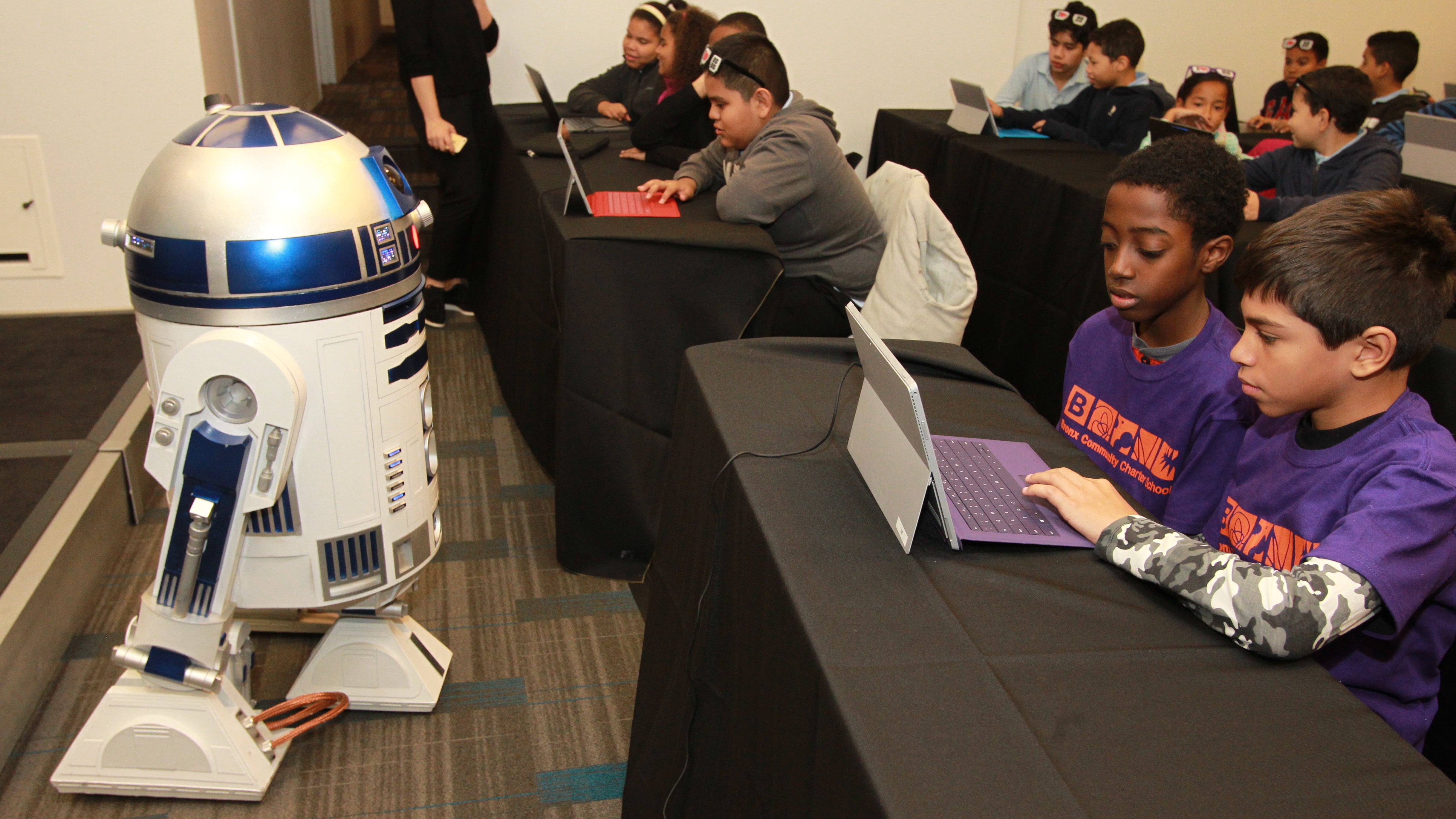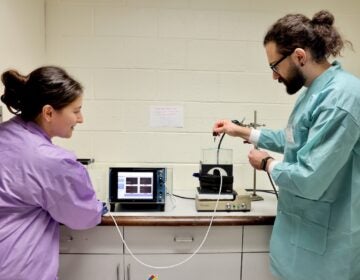Creating the next generation of innovators by understanding how young people use media
Helping kids be creative is the best way to make them innovators. Minecraft, social media, and connected learning tools can build social skills, and drive civic engagement.

R2-D2 joins New York City students at an Hour of Code pep rally hosted by Code.org, Microsoft and Google at Nasdaq MarketSite in 2015. Students were inspired to try coding with Minecraft and Star Wars themed tutorials. (Donald Traill/ AP Images for Microsoft)
On March 21 at 6 p.m., the ExCITe Center of Drexel University will host its second of six Learning Innovation Conversations with anthropologist Mizuko “Mimi” Ito. WHYY invited Youngmoo Kim, director of ExCITe and moderator of the discussion, to share his thoughts on screen time, equity and inclusion of technology, and recognizing those who have inspired learning and innovation.
—
Helping young people be makers and use tools to create is the best way to position them to be innovators.
This idea is central to the work of Dr. Mizuko “Mimi” Ito, a renowned anthropologist who has studied how young people use technology, media, and games and what communities can do both in and out of school to encourage creative approaches to learning.
On Tuesday, March 21, the ExCITe Center at Drexel University will host a conversation with Ito at the Academy of Natural Sciences. We anticipate an open and engaging conversation involving audience participation to reveal links between innovation and what (and who) inspires us.
She’s a ground-breaking researcher who has turned conventional wisdom about media and videogames on its head by examining how these new channels give rise to new forms of creating, socializing, and learning. She also demonstrates how connecting across disciplines can translate research into implementation, helping to launch organizations like LRNG and Connected Camps to build communities of interest around authentic uses of creative technology in education.
Her appearance will be the second of six scheduled Learning Innovation engagements with national leaders taking creative approaches to learning. We expect her to touch on several topics we know Philadelphians care about:
1. Screen time
I have a child in grade school, so Ito’s research hits home, literally, for me and all parents, as we grapple with questions about how much time our children spend watching videos and playing games.
Her research challenges us to consider how Minecraft, social media, and other connected learning tools can spur creativity, build social skills, and even drive interest in civic engagement.
2. Equity and inclusion
Mimi is a strong advocate for using cultural art and creative technology in connected learning to make STEM (science, technology, engineering, and math) education more inclusive of underrepresented groups to improve gender, ethnic, and socioeconomic diversity in these fields.
3. Learning heroes
Good mentors, essential for sustained learning, can come from anywhere. Many of our learning heroes are teachers, but many are also relatives, coaches, and neighbors — and sometimes from online communities.
Ito’s efforts remind us of the importance of recognizing those who have inspired learning and innovation in all of our lives and to understand how the passion to create is passed from person to person.
We know learning doesn’t happen in a vacuum, which is why we’ve structured the Learning Innovation initiative to be about both sharing innovative learning practices and also how we learn to innovate. In our first Learning Innovation conversation with John Maeda in January, he addressed both of these pathways. He reflected on the importance of teachers in his life who recognized his potential and showed the way for what is possible. Maeda also emphasized that being a designer/maker is intrinsic to the innovation process, and when you don’t learn to innovate, you allow others to assume that role.
One need only look to the social media tools and games that Ito studies to see that they reflect the values and preferences of their creators. Catalyzing an interest in learning and a confidence in their own creativity makes students more likely to emerge as future learning heroes for someone else.
We encourage readers to join us on March 21 at 6 p.m. at the historic Academy of Natural Sciences to learn more and share their own experiences. We’re interested in what others do in their teaching and learning practices, as well as the roadblocks that crop up, and what inspires people to pursue their own innovations. We will be asking for audience input during and after the event to continue the conversation and grow this learning innovation community in our region.
—
Youngmoo Kim is director of the Expressive and Creative Interaction Technologies (ExCITe) Center and associate professor of electrical and computer engineering at Drexel University.
Mizuko “Mimi” Ito will speak about the use of technology and young people’s changing relationships to media on Tuesday, March 21 at 6 p.m. at the Academy of Natural Sciences at Drexel University. To attend the conversation, please register. Ito is the MacArthur Foundation Chair in Digital Media and Learning at the University of California-Irvine, Chair of the MacArthur Research Network on Connected Learning, and founder of Connected Camps.
For more details on the Learning Innovation initiative, listen to the most recent podcast and sign up to receive occasional updates.
Drexel University provides financial support to WHYY.
WHYY is your source for fact-based, in-depth journalism and information. As a nonprofit organization, we rely on financial support from readers like you. Please give today.




